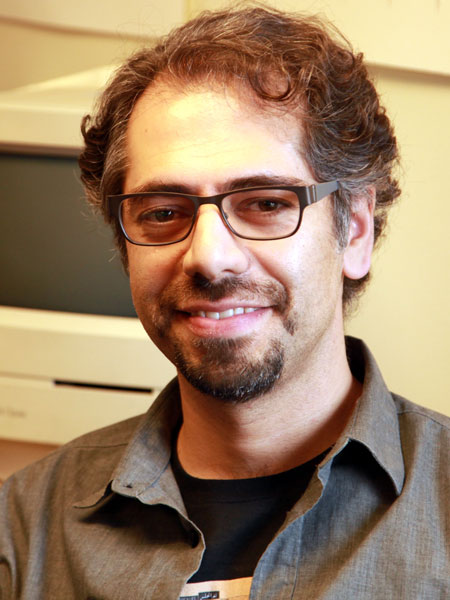A Diverse Future – By Design
Tuesday, March 21, 2017

One boy moved from Mexico to the United States at age 12. Another earned a college degree in South Korea before immigrating. And a third left Iran at age 13, finished his high school equivalency in the U.K. and started junior college in the U.S. at age 15. Two things tie the three of them together: taking risks and starting a Master’s of Fine Arts in Graphic Design at Oklahoma State University.
Mario Bocanegra, the boy from Mexico, will be one of six newly admitted graduate students in the program. Phil Choo, from Seoul, South Korea, is the graduate program director, and Pouya Jahanshahi is a third-year assistant professor in graphic design. Each brings a fascinating perspective to the discipline, which is exactly what faculty members had in mind when creating the program.
“We wanted a diverse group so they could complement each other,” Jahanshahi says. “Much of graduate learning is to learn from each other.”
OSU’s MFA in graphic design becomes its first graduate program in studio art (there is an existing program in art history). It will encompass three distinct areas: visual communication, motion graphics, and interaction design (sometimes called user experience design or UX design). According to Choo, no other program in the Big 12 Conference has that combination.
With national organizations already noticing OSU’s undergraduate work, all six allotted slots were quickly filled. In fact, the goal for 2016-17 was to offer three or four spots and grow the program from there.
“We’re very thrilled,” Choo says. “Fortunately we have a good group of students from different backgrounds, geographical locations and age groups.”
Indeed, with students from India, Korea, New York and Oklahoma, ranging in age from recent college graduate to 44 years old, the student body is a diverse cohort. That level of diversity reflects the faculty and helped persuade Bocanegra to continue his studies after graduating with his bachelor’s degree in fine arts from OSU in May 2016.

“I feel like there will be more surprises,” he says. Bocanegra had many of the faculty members as an undergraduate, and he’s looking forward to all aspects of the graduate program, including research and teaching. Each student is required to take a teaching practicum during their first year and will be able to teach lower-division design courses.
That is all part of what makes the MFA a terminal degree for the discipline. Graduates of the program will have the ability to work in industry or academia, making the MFA equivalent to a doctorate. Choo is excited by what OSU has accomplished in getting the program off the ground but feels the success of the program ultimately relies on its graduates.
“I want the students to become professors or leaders in graphic design, and our program will grow up with that support,” he says.
Both Choo and Jahanshahi feel they grew up during their graduate school years.
For Jahanshahi, this was almost literally the case. He was 15 when he came to the United States to live with his uncle in Los Angeles. At 13, his parents moved him from Iran to London. His father was allowed to leave Iran for business purposes and the whole family migrated to the U.K. to at least temporarily escape the bloody Iran-Iraq War. In his two years there, Jahanshahi studied for and passed all five equivalency exams in the U.K. to qualify for college. All he had to do next was change his country, his language, and start college at age 15.
“Luckily, I was tall,” he jokes.
Because Jahanshahi was not born into the family of a master artist, he had no future as one in Iran. In the U.S., he discovered all sorts of careers he could pursue as an artist. Still, he had to sell his parents on the idea.
“I had to convince my parents, who had sent me across the ocean at great expenditure, that a career in the arts and design had a future,” Jahanshahi says.
He eventually moved on to obtain his master’s degree with a focus on motion and semiotics, at California State University, Fullerton, where he was introduced to the first Macintosh computers. Jahanshahi still keeps one of the relics in his office at OSU. That degree led to work with advertising and design companies, but something was missing.
Twenty years after leaving Iran, he returned and came face-to-face with his ethnic visual culture — the missing piece. He pursued his MFA at California Institute for the Arts, keen to develop a hybrid visual identity for his personal graphic voice.
Jahanshahi credits a class called “Image Making” that involved picking a designer and trying to make things like that designer for taking him out of his “safe space” and pushing him to truly define who he was.
“That’s what I needed to do the whole time,” he says. “It brought out the Iranian in me and the immigrant in me, the hybrid visual thinker. It was about both finding my identity and allowing myself to fail to find something new out of that.”
Choo also sees success coming from taking risks. Like Jahanshahi, Choo found work as a professional designer immediately after graduating from college but felt there was more to know. He decided to study in the U.S. and found a home at Iowa State University.
It was not an easy transition for he could read and translate English but speaking the language had not been part of his education. He soon found his American classmates were happy to help him practice his English. He enjoyed researching interaction design, which had just begun to be studied at the time, and especially took to leading a classroom.
“I didn’t know I could teach until I had an opportunity,” he says. “Since then it’s become a career, and that’s been 14 years now.”
Bocanegra never had Choo for a teacher as an undergraduate, but he got to know the professor through an internship with SST Software in Stillwater. Choo pushed the soon-to-be graduate to apply.
“He mentioned the MFA program to me and I was fascinated by it,” Bocanegra says.
The department, under the guidance of Rebecca Brienen (who also serves as the director for OSU’s School of Visual and Performing Arts), is justifying such enthusiasm with cutting-edge equipment such as eye-tracker technology, laser cutters, and 3D printers. The department also offers unique opportunities for interdisciplinary collaboration with entities across campus such as the App Center, engineering, broadcast journalism, and fashion merchandising. As much as anything, that is what will set OSU apart from the competition.
“We looked at what we are as a land-grant institution and saw that what distinguishes us from purely fine arts schools is a spectrum of science and knowledge they don’t have,” Jahanshahi says.
Bocanegra is one of six who will be the first to take advantage of these opportunities in the new MFA program at OSU. They will be pushed, pulled, and offered a broad range of possibilities and perspectives. What they take from the program will ultimately come from within.
“The most important thing is the curiosity and willingness to take a risk,” Choo says.
Photo Courtesy :Brian Petrotta
Story by Brian Petrotta
